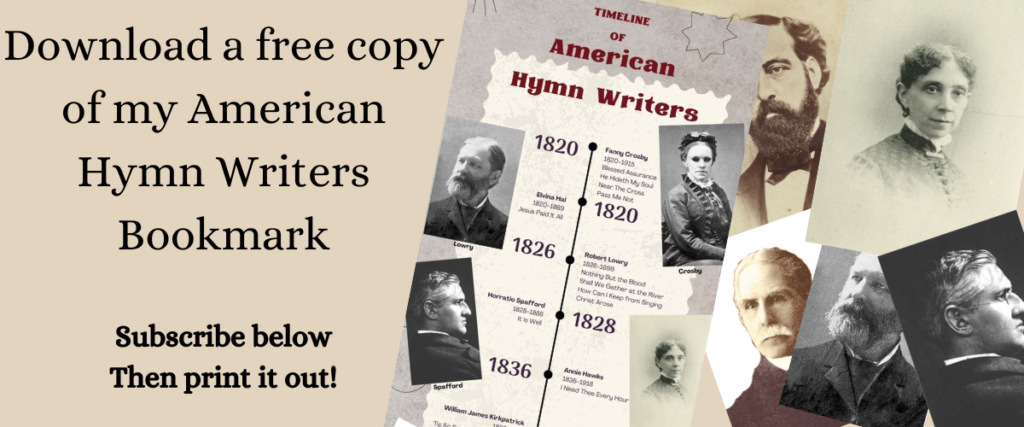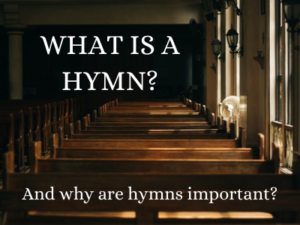What is a Hymn And Why Are Hymns Important In Worship?
No one seems to know what a hymn is anymore. And the confusion extends to all ages and fans of all musical styles. It leaves us asking, “what is a hymn and why are hymns important in worship?” For the purposes of this article, we’ll build the case that a hymn is:
A stanzaic poem in regular meter composed for congregational singing, that is directly addressed to, or about the Triune God-Head, or His Church.
I already know what a hymn is! (Hint, you probably don’t)
I have heard many hymn lovers declare their favorite hymn to be a song that is decidedly not a hymn. (Which is mildly amusing) Likewise, I’ve heard pastors and worship leaders rail against hymns as being outdated and irrelevant, only to reference a “cutting edge” modern worship song that is, in fact, a hymn. Some have even decried the use of hymns as a sign your church is irrelevant.
It isn’t safe to assume that everyone is on the same page. I once spoke with a man who got quite angry with me when I said that churches need to be singing more hymns. He disagreed. After a few probing questions, I realized that his idea of hymnody was church music written between 1880-1920 in the American south. He hated “hymns”, but didn’t know what all that included.
Misunderstandings about hymns generally fall into two categories:
Traditionalists
Though they often don’t understand themselves, traditionalists treat the ancient song of the church like a type of folk music; pleasing to the conservative ears and loaded with nostalgic emotion. The hymns of the traditionalist remind them of a world that no longer exists. They are a chance to reach back and interact with memories of mom and dad, grandma and grandpa. They create a false nostalgia of an unreal past, much like a Thomas Kinkade painting. This is a form of idolatry that isn’t unique to traditionalists.
Traditionalists tend to conflate hymns with subgenres of folk music. Gospel songs, (which are not technically hymns because they are not intended for congregational singing,) and patriotic songs sometimes find their way into worship services and even hymnbooks. This happens because sacred hymnody, which contains the most important message in the world, has been lowered to the level of folk music. Let’s face it, Amazing Grace along with many other hymns has been subconsciously placed in the same category as Old Susanna” and America The Beautiful.
Trend-watching churches
Trend-watching churches on the other hand also see hymns as a style of folk music. But instead of embracing the excellent hymn text, trend watchers tend to throw the baby out with the bath water. Churches in this category dismiss hymns as musical relics from a past that is better off forgotten. Ironically, many of these churches say that they base their worship on the New Testament and historic Christianity. What they really do however, is dismiss the thoughts and lives of the Christians and martyrs who lived during the last two thousand years. Even more ironic, is the fact that worship music for many trend-watching churches is actually based on historic hymnody or hymn themes. Many of these churches go to great lengths to distance themselves from ancient hymnody only to unknowingly incorporate them into their worship.
What is a hymn?
Perhaps folks would be less confused about hymnody if we simply took the time to ask what a hymn really is.
A hymn is not a style of music.
Many folks tend to think of a certain style of music when they think of hymnody. But by their nature, hymns can be sung and played in many styles of accompanying music. They are just as at home with modern bands as with a pipe organ.
Furthermore, the word “hymn” only refers to the poem-text, not the tune. In fact, most tunes have a different name than the underlying text.
For example, Amazing Grace is the name of the classic text. The famous tune we all know is entitled New Britain. In other words, there is no such thing as an instrumental version of Amazing Grace!
Since a hymn is the text and not the music, throwing out all hymns because of musical taste is just plain silly.
Hymns are important for worship because they are designed for congregational singing
Hymns are not designed for soloists. They are not designed for easy listening. They are not for entertainment. And they are not even designed for quiet introspective worship. The purpose of a hymn is for congregational singing. To that end, the hymn serves three functions:
- Hymns are used to adore and worship God.
- Hymns are sung as prayers in that they address God directly.
- Hymns declares Truth.
Hymns are not instrumental music
Because hymns are for singing, they are essentially vocal music. Pick up most hymnals and you’ll see the music written out as soprano, alto, tenor, and bass. These notes were never intended to be played on an instrument. In fact, some passages are impossible to play without modification. Of course, instrumental accompaniment adds to worship. And creative music, whether contemporary or traditional can lead the congregation to more effectively meditate on the text. But unlike contemporary worship anthems, the text of the hymn is always more important than the tune. This is one point where hymns differ from contemporary music.
Contemporary songwriting on the other hand gives equal attention to the lyrics and the music. It is common for contemporary worship songs to build to a harmonic climax near the end of the song. The stanzaic structure of hymns, (hymns have stanzas instead of verses,) however, makes this technique impossible in a hymn without seriously changing the hymn, (which is fine and is sometimes fun!) This should not be taken as a condemnation of contemporary worship. It is simply a difference in focus and method. A key hallmark of the hymn is its use of stanzas as opposed to verses. This is what is meant by “a stanzaic poem in regular meter”. For other points, read the article Why Hymns and CCM are SO Different.
Hymns Are Easy to Sing
Hymns of all genres of music are important in worship because they are, by necessity, accessible to all worshipers, not just those with a fine voice. This means that texts and tunes are easily singable for non professionals. They are not too wordy, because they are limited by the meter in the stanza, and they do not contain high or low notes because everyone has a line of music in their range. This simplicity contrasts with contemporary anthems and Gospel music. Both of which are more rhythmically complex than hymns because they are written for the singer on the radio rather than the enthusiastic, yet tone deaf worshiper in the back pew. Some modern worship music is written in vocal keys not once found in a hymnal.
Hymn Subjects Should be Appropriate for Worship
Because hymns, (and all worship music,) are for congregational singing, the subject matter should be appropriate for the congregation. Unfortunately, even old Gospel songs blur the line in this regard and have become confused with hymns because they were written in a common era and similar style.
Nevertheless, just because a song sounds like a hymn, does not mean that it really is a hymn. Even if it finds its ways into a hymnal. Songs like these meditate on how the author feels about God rather than God himself. They sing of the fond memories of childhood church attendance and “Old Time Religion.”
These songs may be fine for radio or entertainment, but they are not for congregational singing because they do not meet any of the three functions of biblical song.
- They do not adore and worship God.
- They do not address him in prayer.
- And they do not directly declare doctrinal truth as found in scripture.
Most of the songs that do not meet this criteria were never actually written to be used within the congregational context in the first place. Some of them were radio hits or popular folk songs at one time. Though they may be fun and enjoyable, they do not build up the body in any way beyond entertainment. Entertainment is great, but not during worship!
The hymn is not a style of music. It is not even music at all. The hymn is a verbal device designed to effectively lead God’s people in worship of their creator. This makes them useful and potent no matter what style of music they are paired with.


